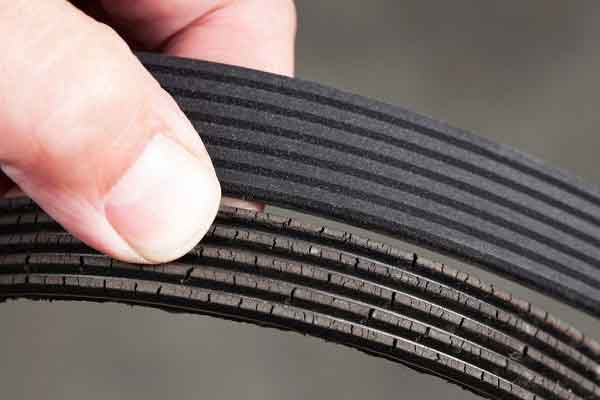In this article, we will talk about car drive belts, a belt that is not given as much importance as it deserves. The drive belt is a belt made of reinforced rubber with ribs.
A drive belt is an important piece located in the engine compartment that is crucial for the proper functioning of the car accessories like the alternator, power steering, and car AC.
Contents
Role of a car drive belt
In order to function properly, an engine needs several accessories in order to operate under normal parameters. Almost all engines today are controlled by a central computer (ECU) that takes data from several sensors, calculates certain values , and then makes the settings for the engine to function properly. Well, this computer and these sensors have to be powered by electricity from somewhere, so by default, we have an alternator that is powered by the motor with the help of the drive belt.
The power steering also works with the hydraulic pressure generated by the power steering pump, which in turn is driven by the motor through the drive belt. Also for cars with an air conditioning system, the AC compressor is also fitted with a drive belt. Most cars nowadays have only one accessory belt, but in slightly older cars there are two drive belts sometimes even three.
In some cars with a timing chain system, the water pump is engaged by the drive belt, so it is much more important because if the drive belt happens to break the car will no longer run because the water pump will no longer be engaged and therefore the engine will stop, it will overheat.
Importance of the drive belt
Although most people do not give too much attention to this car part, this belt is very important because it is used permanently, since we start the engine until we stop it, running accessories keep the engine and the whole car running, to supply electricity, to have power steering, climate, everything that is needed.
This belt should normally be checked every 10,000 km (~ 6300 miles), or rather every oil change, we need to check the drive belt, the guide rollers, and the tensioner.
How long does an drive belt last?
A normal drive belt can last a maximum of 80-90,000 km (49.500 – 56.000 miles), and one made of EPDM rubber can withstand up to 200,000 km (124.000 miles), but if I were in this situation, I would change the drive belt along with the timing kit, about, 60-75,000 km (37.000 – 46.000 miles).
Together with the timing kit and drive belt. I would change the rollers as well, and at about 120-150,000 km (74.000 – 93.000 miles) I will also change the tensioner to prevent any problems that may occur in the future.
Symptoms of a bad car drive belt
Although the belt will last you a long time, there are some signs of aging and wear that you must be very careful about.
- Scrapings under the hood (may indicate a wide belt);
- Noise;
- Cracks in the belt;
- Grooves, cuts or breaks in the belt;
- Missing grooves on the inner surface of the strap;
- Power steering does not work (indicates a problem with the belt or power steering);
- Battery light error lit when the car is running.
- Visual wear, you can see with the naked eye that the surface of the belt is different from a new one, you can see cracks or even small missing pieces;
Of all the symptoms presented above, noise is the most common symptom. Maybe squeaking, maybe whistling. Because it does not have to make any noise normally when these noises begin to be heard it means that it must be replaced.
The recommendation is when you replace it, change the tensioner roll as well. If you change the belt and the roller is faulty, you will have to pay the labor again to replace the roller.
Belt noise can be caused by the actual wear and tear, but also by the presence of oil or water on the belt’s surface. In the case of water, there is no problem. In the case of oil, the belt must be replaced and found where the oil reaches the belt.

What happens when the drive belt breaks?
If the drive belt breaks, you will see that the driving experience is greatly altered. Without this belt, the power steering will not work, the air conditioning will not work, not even the alternator will start. This means that you will go to the battery until the engine consumes it completely and will stop.
Nothing bad happens if the belt breaks, we cannot compare the situation with the case of a timing belt. If it breaks, remove the strap to avoid the moving parts to block.
How to check the drive belt?
Checking the drive belt is easy, the belt should not have cracks on the contact surface, it should have no material removed from it, and it should have some flexibility. The guide rollers should also have no cracks or cracks on the contact surface and make no noise. The tensioner is checked quite easily, you can simply see if the drive belt is tight enough, click on it and it should be difficult enough to stretch it.
